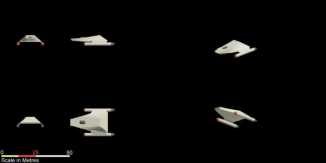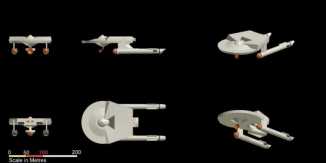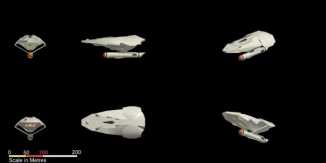The Ptolemy class transport was the first in a line of successful high-load warp transports used by the Federation. Equipped with specially designed warp engines suitable for towing mass never before realized, the vessels were a boon to infrastructure building outside the core of the Federation. Initially, production contracts called for 30 ships of this class to be constructed. However, due to the fleet-wide ship build-up at the time it was commissioned, limited appropriations permitted the construction of only 15 of the class.
The Ptolemy class was designed for easy and efficient transporting of cargo within outboard cargo containers. The cargo containers were easily attached and detached via a specially designed coupling unit fitted to the neck of the primary hull of the starship. Depending upon total mass, up to two containers could be towed by the Ptolemy at one time. These containers were mass-produced and supplied to both Starfleet and private shipping concerns (at a reduced rate) to promote the use of these standardized containers. Practically a ship unto themselves, these containers were a break-through in shipping technology just as the high-load warp engines mounted on the Ptolemy were.
The containers came in five basic types:
- Mk I Liquids
- Mk II Dry Bulk Goods
- Mk III Refrigerated/Thermal Goods
- Mk IV People (starliners, mass transport)
- Mk V Products (non-food stuffs and misc.)
The Mk I-III and V containers had their own cargo transporters (up to six), turbolifts for carrying goods to various levels and self-contained environmental machinery. The Mk IV containers also included 6 personal transporters and could accommodate 800 passengers. This container also had its own sensors array, was capable of sub-light speed and could sustain its passengers in case of an emergency for up to 18 years.
During the Four Years War, an urgent need arose for military cargo transports. Because of their slow speeds, the Ptolemy was not a viable candidate. However, the need was so great that all Ptolemys in service at the time were converted to Mk IIs. The Mk II mounted the FWB-1 engine which improved the speed of the transport, but at the cost of limited cargo capacity. The Mk II could only carry approximately 121,000 mt of cargo in smaller outboard cargo containers. However, this was sufficient in its role as a military transport.
After the Four Years War, surviving Ptolemys were retrofitted with the FHLWA-1 and returned to their pre-war roles. Many of the Mk IV containers were converted to starliners, with luxurious accommodations for up to 500 passengers. These starliners contained a park promenade, numerous recreation lounges, 2 full theaters, a gymnasium, pool and hydroponic gardens.
This modified version was first built in 2242 alongside the standard version, it featured more discreet hull mounted deflectors as opposed to the large dish of the standard ships. Post war most of the class were converted to this standard, which gave no performance benefits, but considerably improved reliability.
| Class: | VII | Year: | 2242 | |
| Ship Source: | Starfleet Technical Manual/The Starfleet Museum | Ship Datasheet: | Download PDF |




















You must be logged in to post a comment.